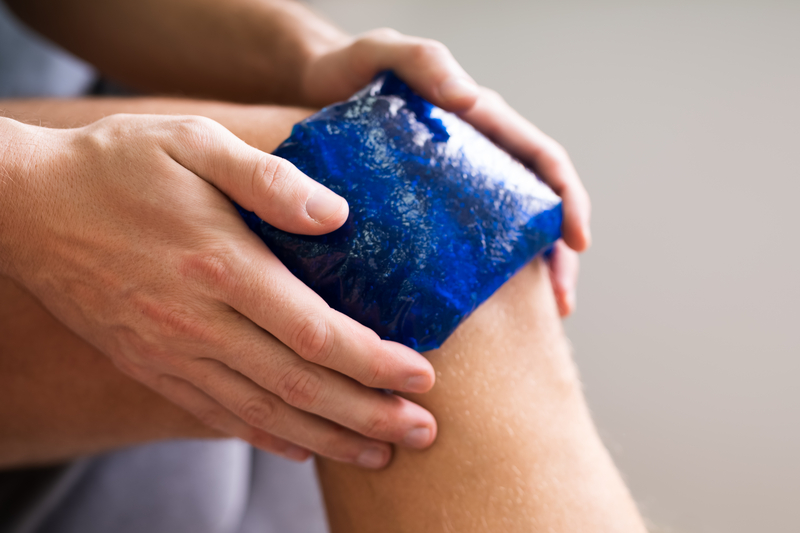When to Use Heat or Ice for Body Pains

So, you’re injured and you want to treat your symptoms, but you’re not sure when to use heat or ice. How do you decide when it’s appropriate for a hot compress and when is it better to use an ice pack? It can be confusing and there are differing schools of thought, but a few simple principles may help.
Keep in mind, there are also instances when some form of icing and some form of heat may both be appropriate for the same event.
When to Use Heat

It may be difficult to determine exactly when to use heat or ice on an injury, but there are some specific times when heat can be the more beneficial of the two. Additionally, not all heat treatments are the same. There are two types of heat that are often recommended—dry heat and moist heat—and their use will depend on the type of malady you are treating.
A quick rule of thumb that can help when determining whether to use ice or heat involves picturing the outcome. When it comes to exercising, simply think of the phrase “warm up.” Heat speeds things up and brings blood to muscles and helps your body loosen up, so it’s more pliable. So, when working with areas that need some TLC like sore muscles, heat is your best bet.
Stretching—never ice before stretching; always use heat. Using heat before and during stretching helps to bring blood and nutrients to the tissues, resulting in better flexibility.
Tendonosis—unlike tendonistis, tendonosis is a degeneration of the tendon itself that’s typically incurred through excessive repetitive motions. Using heat on these areas can help to speed healing.
Eye issues—irritated, swollen eyes or eyelids, bruises, dry eye, styes, and allergies can find some relief by using a warm wet compress over the eyes. For eye use, ensure that you use only water and no additives, oils, or other medications.
Stiff neck and other sore muscles—you may be able to reduce the pain from sore muscles with a heat treatment. Chronic pain seems to respond well to regular heat treatments.
Stiff joints—as with stiff muscles, warming the areas can provide relief, and the extra blood flow can allow the areas to become more pliable.
How to Apply Heat
You have a lot of options when it comes to applying heat to sore or injured areas.
Heating pad—this can be used to treat many injuries. Heating pads may consist of a balloon type of device that you fill with hot water, a pad that you plug in (an electric heating pad), or a microwaveable pouch. Some heating pads will include a layer that you can wet and reinsert so the heating pad gives off a moist heat.
Hot or warm compress—this is a fresh towel or washcloth soaked in warm water and laid over the injured area.
Gel heat pack—the flip side of the drugstore ice pack, some of these can also be microwaved in order to produce a soothing, long-lasting heat treatment.
Warm bath—baths are soothing and can help you relax as well as ease sore muscles and minor aches and pains. Try adding Epsom salts for an added benefit for sore muscles.
Saunas and steam rooms—saunas have a wonderful healing dry heat, and steam rooms provide the perfect moist heat. Try to limit your time in either one to about 15 minutes, and ensure that you stay plenty hydrated if you’re going to use these.
When to Use Ice

And then there are times when using heat on an injury can cause more harm than good. Because heat can exacerbate the inflammation typically already present in an injury, sometimes adding more heat can be problematic. This is when keeping things on ice is your best bet. Think “ice is for injuries.”
Bruising—in the case of bleeding and bruising, you’ll want to “cool down” the area by icing and slowing the flow of blood. Icing can help reduce overall bruising.
Swelling—some swelling is healthy and healing to a degree, but when it’s time to reduce inflammation, it’s time to ice. General pain can often be tempered by a few rounds of icing.
Minor sprains and strains—since ice calms, applying an ice pack to the affected area can help minimize swelling and bruising while reducing pain.
Headaches and migraines—most folks will benefit from a cold compress on the forehead. In addition to regular headache medication, a cold treatment can help calm angry nerves. On the other hand, some headaches, like tension headaches, seem to respond better to heat. And don’t be surprised to find that alternating both hot and cold treatments may be the most effective.
Tendonitis—unlike tendonosis, tendonitits is an inflammation of the tendon due to small tears, usually the result of an overload or a sudden overload injury. Because of the nature of this injury and the need to reduce inflammation, the use of ice is indicated. Try icing for 15 minutes at a time, several times a day.
How to Apply Ice
Using ice is fairly straightforward, but there are a few parameters you should follow. Only use ice for about 15 – 20 minutes at a time.
Ice cubes—use caution if applying ice to bare skin. Don’t keep it in the same place, but instead, move the ice around if you do not have a barrier between your skin and the ice.
Ice pack—you’ve seen them everywhere from doctors’ offices to your local drugstore. A simple ice pack can be kept in the freezer and produced at any time to calm and sooth injuries. Again, remember to protect your bare skin.
Frozen vegetables—a nice bag of frozen peas can be the perfect ice pack as the peas are small enough to settle in around the area and the gentle cooling can help relieve pain and inflammation.
Ice bath—you’ve probably seen athletes sitting in ice baths after strenuous workouts. The idea is to reduce muscle soreness and help the body avoid excessive inflammation after an intense exercise session.
Full-body cryotherapy—some folks will even use ice chambers to lower the temperature of their entire bodies. This typically involves standing in a cryo chamber while the temperature dips below -200 degrees for several minutes. Cryo treatments are said to help reduce pain and inflammation as well as promote fat loss in some folks.
The next time you experience a sore muscle or injury, you’ll know exactly which method to use. Of course, if you are seriously injured (e.g., torn muscle or broken bone or dislocated joint), go straight to your doctor or ER. There will be plenty of time to determine whether to ice or heat once the acute injury is taken care of.




 7 Signs Your Body is Seriously Low on Collagen (not just wrinkles)
7 Signs Your Body is Seriously Low on Collagen (not just wrinkles) Health Expert: "Turmeric Doesn't Work (unless...)"
Health Expert: "Turmeric Doesn't Work (unless...)" 3 Warning Signs Your Probiotic Supplement is a Total Waste
3 Warning Signs Your Probiotic Supplement is a Total Waste

